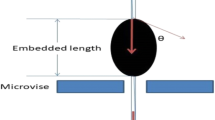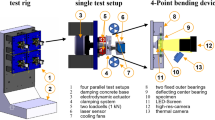Abstract
Single-fibre pull-out experiments have been carried out with glass fibres with and without silane coupling agents. Debonding was easiest when the fibre had a commercial coating on it which contained a silane and processing aids, and was relatively thick. Solvent extraction of the coating increased the bond strength, and total removal of it increased it still further. The strongest bonds were stronger than the polymer and probably failed by brittle fracture with a work of about 0.25 kJ m−2, much less than the estimated work of fracture of the polymer. After debonding, frictional sliding took place, with an interfacial pressure of 17 M Pa, and with a coefficient of friction that was influenced by the interface in the same way as was the bond strength, i.e. greatest for the bare fibre, and least for the coated fibre. The silane coupling agent plasticized the polyester, and it seems highly probable that debonding took place in the interphase, when the fibre was coated, so that frictional sliding during post-debond pull-out was between the chemisorbed layer of silane and the polymer. The physisorbed layer of silane probably dissolved in the polymer, because the friction was not affected by solvent extraction.
Similar content being viewed by others
References
P. W. Erickson andE. P. Plueddemann, in “Composite Materials”, Vol. 6, Interfaces in Polymer Matrix Composites edited by E. P. Plueddemann (Academic Press, New York, 1974) Chs 1 and 6.
R. T. Graf, J. L. Koenig andH. Ishida,J. Adhesion 16 (1983) 97.
B. Harris, P. W. R. Beaumont andE. M. De Ferran,J. Mater. Sci. 6 (1971) 238.
J. P. Favre andJ. Perrin,ibid. 7 (1972) 1113.
N. J. Wadsworth andI. Spilling,Brit. J. Appl. Phys. 1 (1968) 1049.
B. Miller, P. Muri andL. Rebenfield,Comp. Sci. Tech. 28 (1987) 17.
J. F. Mandell, D. H. Grande, T. H. Tsiang andF. J. McGarry, ASTM STP 893 (American Society for Testing and Materials, Philadelphia, 1986) p. 87.
M. R. Piggott, in “Advances in Composites: Chemical and Physico Chemical Aspects”, edited by T. L. Vigo and B. Kinzig (VCH, New York, 1991) Ch. 9 in press.
P. S. Chua andM. R. Piggott,Comp. Sci. Tech. 22 (1985) 185.
M. R. Piggott andP. S. Chua,Ind. Eng. Chem Product RID 26 (1986) 672.
P. S. Chua andM. R. Piggott,Comp. Sci. Tech. 22 (1985) 107.
Idem., ibid.22 (1985) 33.
M. R. Piggott,Comp. Sci. Tech. 42 (1991) 57.
E. P. Bowden, A. Moore andD. Tabor,J. Appl. Phys. 14 (1943) 80.
A. Gaur, B. Miller andD. E. Hirt,Comp. Sci. Tech. 42. (1991) 207.
Author information
Authors and Affiliations
Rights and permissions
About this article
Cite this article
Chua, P.S., Dai, S.R. & Piggott, M.R. Mechanical properties of the glass fibre-polyester interphase. J Mater Sci 27, 913–918 (1992). https://doi.org/10.1007/BF01197641
Received:
Accepted:
Issue Date:
DOI: https://doi.org/10.1007/BF01197641




